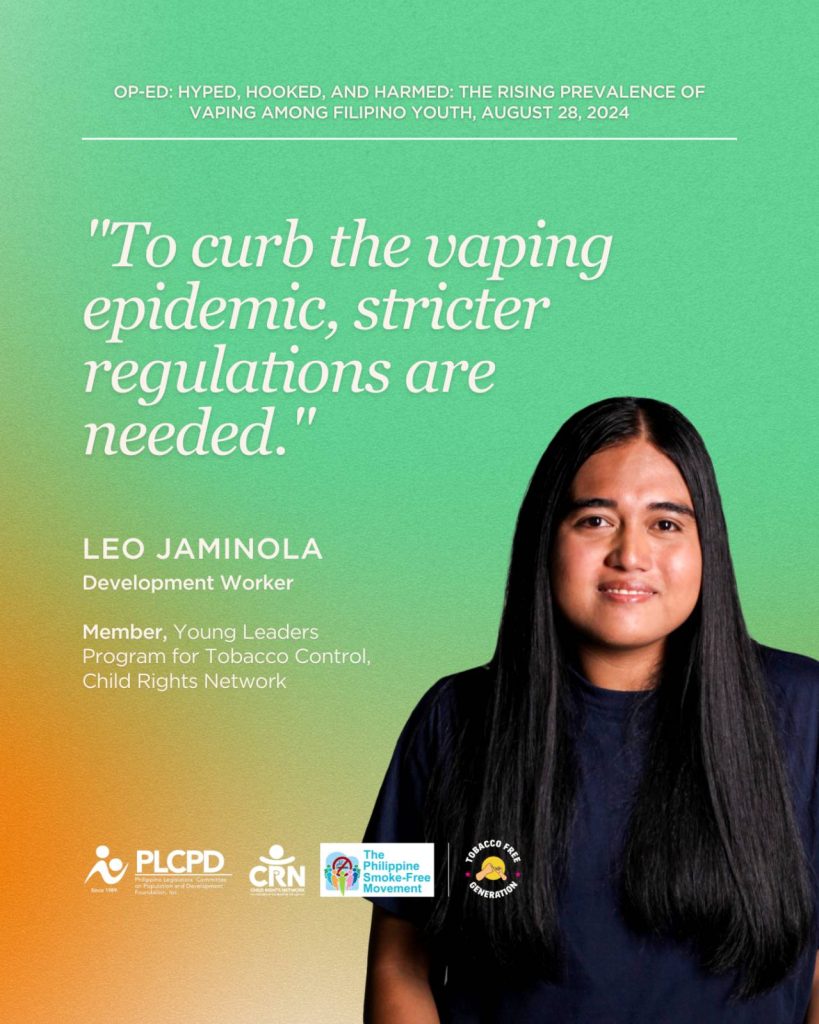Hyped, hooked, and harmed: The rising prevalence of vaping among Filipino youth
By: Leo Jaminola

The Philippines is currently seeing a sharp increase in the use of vapes or e-cigarettes among young people.
The 2019 Global Youth Tobacco Survey (GYTS) estimated that 1 in 7 students aged 13-15 currently use e-cigarettes. The GYTS survey also found that boys in this age group are more likely to use e-cigarettes than girls.
Easy access to e-cigarettes and devious marketing tactics targeting the youth are fuelling the rise in the use of e-cigarettes among the Filipino youth.
For example, despite prohibitions in selling tobacco products near schools, a study by the Institute for Global Tobacco Control (IGTC) showed that more than 2000 retailers located within 100 meters of 276 schools continue to sell cigarettes, e-cigarettes, and heated tobacco products – a clear violation of the law.
The study found that e-cigarettes were usually available in vape shops and convenience stores.
Meanwhile, tobacco companies and retailers further exploit the increased accessibility of young people to vapes by rolling out marketing tactics designed to hook young people.
There are over 16,000 e-cigarette flavors, some featuring cartoon characters and youthful designs. Stores are also guilty of prominently displaying “power walls” of tobacco products and running indoor and outdoor advertisements.
The online availability of vapes has also been cited as the top access point of students for buying these products. The study by IGTC showed that tobacco companies get away with online marketing – websites of 15 vape and heated tobacco brands used flavor descriptors to market their products.
All websites also used various promotion strategies such as giving discounts, waiving shipping fees, and offering free gifts to further attract consumers.
Unfortunately, this is our policy environment: the rise of vape use especially among young people is happening against the backdrop of the easing of vape regulation through Republic Act 11900 or the Vaporized Nicotine and Non-Nicotine Products Regulation Act.
Several provisions under the law made vapes more accessible to the public, especially to the youth. This includes lowering the minimum age for the purchase of e-cigarettes from 21 to 18 years old and assigning oversight to the Department of Trade and Industry (DTI), which was originally assigned to the Department of Health’s Food and Drug Administration (FDA). The law has also eased restrictions on flavors.
This is dangerous because our legislation favored the tobacco industry here in many ways.
Lowering the age of access plays to their advantage because the younger the person, the more vulnerable the person is to forming addictions. We all know that the industry needs its replacement smokers in order to survive.
Transferring regulatory functions to DTI also favors the industry because it has no technical capacity to test the products, whereas FDA will help ensure the protection of public health.
Early this year, the Department of Health reported the first documented case of death resulting from e-cigarette or vape-associated lung injury or EVALI – a 22-year-old with no prior health conditions but had been vaping daily for two years.
This proves that vapes are not harmless, contrary to promotional tactics claiming that these products have reduced risks or are better alternatives to traditional cigarettes.
We must act now before more EVALI cases and deaths happen.
To curb the vaping epidemic, stricter regulations are needed.
I join my fellow youth in calling for the amendment of RA 11900 to raise the minimum age to 21, ban flavors, ban online sale and marketing, and bring the regulation of vapes back to the FDA.
There should also be stricter enforcement of existing bans on sales and advertising of tobacco products near schools.
Finally, a nationwide campaign debunking disinformation about vapes and highlighting its dangers is essential to counter industry disinformation and protect public health.
